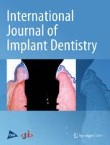Accuracy of guided surgery using the silicon impression and digital impression method for the mandibular free end: a comparative study
International Journal of Implant Dentistry volume 7, Article number: 2 (2021)
Abstract
Background
Implant treatment using guided surgery is becoming widespread in clinical dental practice. Furthermore, the development of digital technology has enabled the use of intraoral scanners (IOSs) to fabricate surgical guide plates. The objective of this study was to compare the accuracy of guided surgery using the silicone impression method with a three-dimensional (3D) scanner and the digital impression method with IOS for one side of the mandibular free end. In addition, we compared the accuracy of tooth-supported vs tooth/mucosa-supported surgical guide plates.
Results
The accuracy of the tooth-supported surgical guide plate using the new IOS method instead of the method of obtaining impressions with conventional silicone resulted in better measurements of 3D deviation at the crest, 3D deviation at the apex, and angular deviation. In terms of the accuracy of the tooth/mucosa-supported surgical guide plate, there were no significant differences in all measurements. The surgical guide plate using an IOS and the tooth/mucosa-supported surgical guide plate may enable more accurate guided surgery.
Conclusion
Tooth/mucosa-supported guided surgery involving preparation with an IOS may result in more accurate implant surgery.

Comments